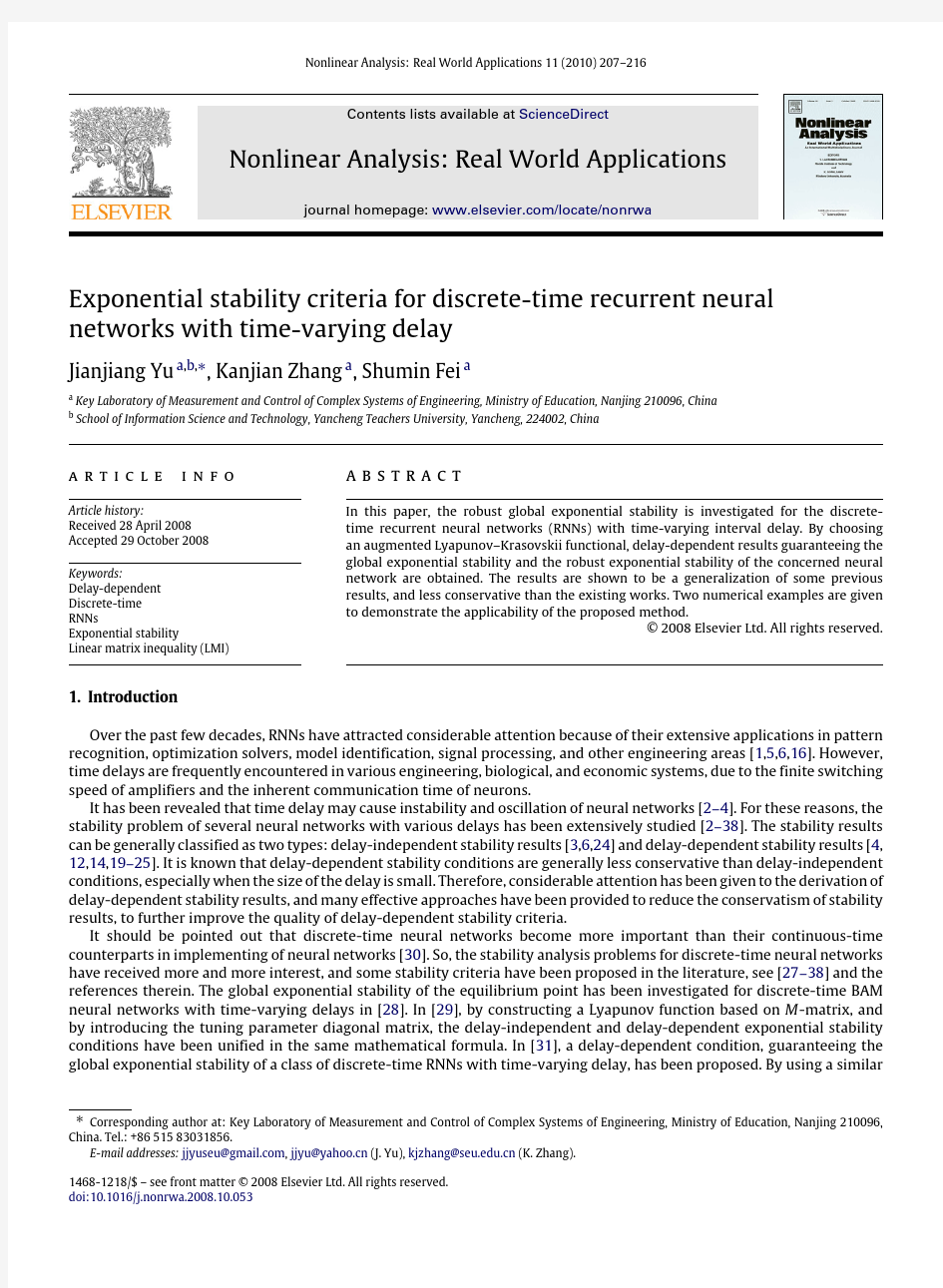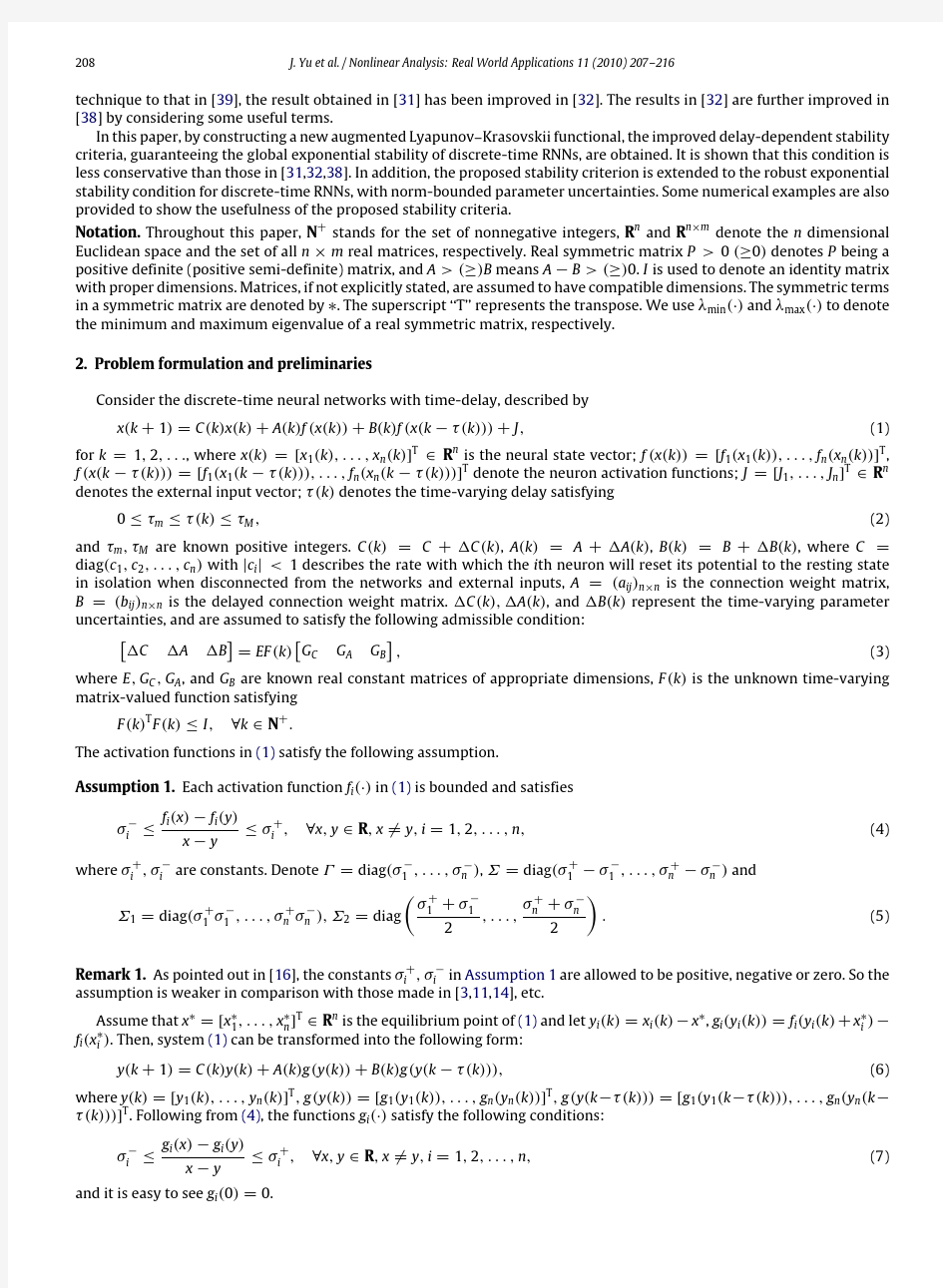(2)Exponential stability criteria for discrete-time recurrent neural networks with time-varying de


电池参数设置
Description The Battery block implements a generic dynamic model parameterized to represent most popular types of rechargeable batteries. The equivalent circuit of the battery is shown below: Lead-Acid Model Discharge model (i* > 0) f1(it,i?,i,Exp)=E0?K?QQ?it?i??K?QQ?it?it+Laplace?1(Exp(s)Sel(s)?0). Charge Model (i* < 0) f2(it,i?,i,Exp)=E0?K?Qit+0.1?Q?i??K?QQ?it?it+Laplace?1(Exp(s)Sel(s)?1s). Lithium-Ion Model Discharge Model (i* > 0) f1(it,i?,i)=E0?K?QQ?it?i??K?QQ?it?it+A?exp(?B?it). Charge Model (i* < 0) f2(it,i?,i)=E0?K?Qit+0.1?Q?i??K?QQ?it?it+A?exp(?B?it). Nickel-Cadmium and Nickel-Metal-Hydride Model Discharge Model (i* > 0) f1(it,i?,i,Exp)=E0?K?QQ?it?i??K?QQ?it?it+Laplace?1(Exp(s)Sel(s)?0). Charge Model (i*< 0) f2(it,i?,i,Exp)=E0?K?Q↓↓it↓↓+0.1?Q?i??K?QQ?it?it+Laplace?1(Exp(s)Sel(s)?1s),
计量经济学术语(国际经济与贸易)
计量经济学术语 A 校正R2(Adjusted R-Squared):多元回归分析中拟合优度的量度,在估计误差的方差时对添加的解释变量用?一个自由度来调整。 对立假设(Alternative Hypothesis):检验虚拟假设时的相对假设。 AR(1)序列相关(AR(1) Serial Correlation):时间序列回归模型中的误差遵循AR(1)模型。 渐近置信区间(Asymptotic Confidence Interval):大样本容量下近似成立的置信区间。 渐近正态性(Asymptotic Normality):适当正态化后样本分布收敛到标准正态分布的估计量。 渐近性质(Asymptotic Properties):当样本容量无限增长时适用的估计量和检验统计量性质。 渐近标准误(Asymptotic Standard Error):大样本下生效的标准误。 渐近t 统计量(Asymptotic t Statistic):大样本下近似服从标准正态分布的t统计量。 渐近方差(Asymptotic Variance):为了获得渐近标准正态分布,我们必须用以除估计量的平方值。 渐近有效(Asymptotically Efficient):对于服从渐近正态分布的?一致性估计量,有最小渐近方差的估计量。 渐近不相关(Asymptotically Uncorrelated):时间序列过程中,随着两个时点上的随机变量的时间间隔增加,它们之间的相关趋于零。 衰减偏误(Attenuation Bias):总是朝向零的估计量偏误,因而有衰减偏误的估计量的期望值小于参数的绝对值。 自回归条件异方差性(Autoregressive Conditional Heteroskedasticity, ARCH):动态异方差性模型,即给定过去信息,误差项的方差线性依赖于过去的误差的平方。 ?一阶自回归过程[AR(1)](Autoregressive Process of Order One [AR(1)]):?一个时间序列模型,其当前值线性依赖于最近的值加上?一个无法预测的扰动。 辅助回归(Auxiliary Regression):用于计算检验统计量——例如异方差性和序列相关的检验统计量——或其他任何不估计主要感兴趣的模型的回归。 平均值(Average):n个数之和除以n。 B 基组、基准组(Base Group):在包含虚拟解释变量的多元回归模型中,由截距代表的组。 基期(Base Period):对于指数数字,例如价格或生产指数,其他所有时期均用来作为衡量标准的时期。 基期值(Base Value):指定的基期的值,用以构造指数数字;通常基本值为1或100。 最优线性无偏估计量(Best Linear Unbiased Estimator, BLUE):在所有线性、无偏估计量中,有最小方差的估计量。在高斯—马尔科夫假定下,OLS是以解释变量样本值为条件的贝塔系数(Beta Coef?cients):见标准化系数。 偏误(Bias):估计量的期望参数值与总体参数值之差。 偏误估计量(Biased Estimator):期望或抽样平均与假设要估计的总体值有差异的估计量。 向零的偏误(Biased Towards Zero):描述的是估计量的期望绝对值小于总体参数的绝对值。 二值响应模型(Binary Response Model):二值因变量的模型。 二值变量(Binary Variable):见虚拟变量。 两变量回归模型(Bivariate Regression Model):见简单线性回归模型。 BLUE(BLUE):见最优线性无偏估计量。 Breusch-Godfrey 检验(Breusch-Godfrey Test):渐近正确的AR(p)序列相关检验,以AR(1)最为流行;该检验考虑到滞后因变量和其他不是严格外生的回归元。 Breusch-Pagan 检验(Breusch-Pagan Test):将OLS残差的平方对模型中的解释变量做回归的异方差性检验。 C 因果效应(Causal Effect):?一个变量在其余条件不变情况下的变化对另?一个变量产生的影响。 其余条件不变(Ceteris Paribus):其他所有相关因素均保持固定不变。 经典含误差变量(Classical Errors-in-Variables, CEV):观测的量度等于实际变量加上?一个独立的或至少不相关的测量误差的测量误差模型。 经典线性模型(Classical Linear Model):全套经典线性模型假定下的复线性回归模型。 经典线性模型(CLM)假定(Classical Linear Model (CLM) Assumptions):对多元回归分析的理想假定集,对横截面分析为假定MLR.1至MLR.6,对时间序列分析为假定 对参数为线性、无完全共线性、零条件均值、同方差、无序列相关和误差正态性。 科克伦—奥克特(CO)估计(Cochrane-Orcutt (CO) Estimation):估计含AR(1)误差和严格外生解释变量的多元线性回归模型的?一种方法;与普莱斯—温斯登估计不同,科克伦—奥克特估不使用第?一期的方程。 置信区间(CI)(Con?dence Interval, CI):用于构造随机区间的规则,以使所有数据集中的某?一百分比(由置信水平决定)给出包含总体值的区间。 置信水平(Con?dence Level):我们想要可能的样本置信区间包含总体值的百分比,95%是最常见的置信水平,90%和99%也用。 不变弹性模型(Constant Elasticity Model):因变量关于解释变量的弹性为常数的模型;在多元回归中,两者均以对数形式出现。 同期外生回归元(Contemporaneously Exogenous):在时间序列或综列数据应用中,与同期误差项不相关但对其他时期则不?一定的回归元。 控制组(Control Group):在项目评估中,不参与该项目的组。 控制变量(Control Variable):见解释变量。 协方差平稳(Covariance Stationary):时间序列过程,其均值、方差为常数,且序列中任意两个随机变量之间的协方差仅与它们的间隔有关。 协变量(Covariate):见解释变量。 临界值(Critical Value):在假设检验中,用于与检验统计量比较来决定是否拒绝虚拟假设的值。 横截面数据集(Cross-Sectional Data Set):在给定时点上从总体中收集的数据集 D 数据频率(Data Frequency):收集时间序列数据的区间。年度、季度和月度是最常见的数据频率。 戴维森—麦金农检验(Davidson-MacKinnon Test):用于检验相对于非嵌套对立假设的模型的检验:它可用相争持模型中得出的拟合值的t检验来实现。 自由度(df)(Degrees of Freedom, df):在多元回归模型分析中,观测值的个数减去待估参数的个数。 分母自由度(Denominator Degrees of Freedom):F检验中无约束模型的自由度。 因变量(Dependent Variable):在多元回归模型(和其他各种模型)中被解释的变量。
EMA指数平均数指标的推导
EMA(Exponential Moving Average)是以指数式递减加权的移动平均。EMAtoday=α * Pricetoday + ( 1 - α ) * EMAyesterday;平滑系数α 平滑系数α 1/1/a,所以 p1表示今天价格,p2表示昨天价格,以此类推。 从该式中可以更清楚地看出EMA加权平均的特性。在EMA指标中,每天价格的权重系数以指数等比形式缩小。时间越靠近当今时刻,它的权重越大,说明EMA 函数对近期的价格加强了权重比,更能及时反映近期价格波动情况。所以EMA 比MA更具参考价值,而EMA也不容易出现死叉和金叉,所以一旦出现要立即作出反映!对周线处理,EMA就更加稳定了。 理解了MA,EMA的含义后,就可以理解其用途了,简单的说,当要比较数值与均价的关系时,用MA就可以了,而要比较均价的趋势快慢时,用EMA更稳定;有时,在均价值不重要时,也用EMA来平滑和美观曲线。 MACD称为指数平滑异同平均线(Moving Average Convergence集合/ Divergence 分叉),是从双指数移动平均线发展而来的,由快的指数移动平均线(EMA12)减去慢的指数移动平均线(EMA26)得到快线DIF,再用2×(快线DIF-DIF的9日加权移动均线DEA)得到MACD柱。MACD的意义和双移动平均线基本相同,即由快、慢均线的离散、聚合表征当前的多空状态和股价可能的发展变化趋势,但阅读起来更方便。当MACD从负数转向正数,是买的信号。当MACD从正数转向负数,是卖的信号。当MACD以大角度变化,表示快的移动平均线和慢的移动平均线的差距非常迅速的拉开,代表了一个市场大趋势的转变。
Hibernate中Criteria的完整用法
QBE (Query By Example) Criteria cri = session.createCriteria(Student.class); cri.add(Example.create(s)); //s是一个Student对象 list cri.list(); 实质:创建一个模版,比如我有一个表serial有一个giftortoy字段,我设置serial.setgifttoy("2"), 则这个表中的所有的giftortoy为2的数据都会出来 2: QBC (Query By Criteria) 主要有Criteria,Criterion,Oder,Restrictions类组成 session = this.getSession(); Criteria cri = session.createCriteria(JdItemSerialnumber.class); Criterion cron = Restrictions.like("customer",name); cri.add(cron); list = cri.list(); ============================== 比较运算符 HQL运算符QBC运算符含义 = Restrictions.eq() 等于 <> Restrictions.not(Exprission.eq()) 不等于 > Restrictions.gt() 大于 >= Restrictions.ge() 大于等于 < Restrictions.lt() 小于 <= Restrictions.le() 小于等于 is null Restrictions.isnull() 等于空值 is not null Restrictions.isNotNull() 非空值 like Restrictions.like() 字符串模式匹配 and Restrictions.and() 逻辑与 and Restrictions.conjunction() 逻辑与 or Restrictions.or() 逻辑或 or Restrictions.disjunction() 逻辑或 not Restrictions.not() 逻辑非 in(列表) Restrictions.in() 等于列表中的某一个值 ont in(列表) Restrictions.not(Restrictions.in())不等于列表中任意一个值 between x and y Restrictions.between() 闭区间xy中的任意值 not between x and y Restrictions.not(Restrictions..between()) 小于值X或者大于值y 3: HQL String hql = "select https://www.360docs.net/doc/4e9903375.html, ,avg(s.age) from Student s group by https://www.360docs.net/doc/4e9903375.html,"; Query query = session.createQuery(hql); list = query.list(); .... 4: 本地SQL查询 session = sessionFactory.openSession(); tran = session.beginTransaction();
presentation evaluation criteria
Professional Studies Presentation Evaluation Criteria The numbers in the top of the boxes are points in a continuum. For example, you can assign 20 points for Organization. As long as you do not give more points than suggested in the leftmost box, the score will range between 0 and 100 when you add up the numbers. Organization (20%) 20 Consistently clear, concise, well organized. Points were easy to follow because of the organization. Transitions between sections smooth and coordinated. 15Usually clear, concise, well organized. Most of the presentation was easy to follow. Transitions between sections usually coordinated. 10Not always clear or concise. Organization was adequate, but weak. Occasionally wandered and was sometimes difficult to follow. Transitions between sections weak. 5Often unclear and disorganized, rambled too much. The presentation was confusing and difficult to follow. Transitions between sections awkward. Topic Knowledge (20%) 20Displayed an excellent grasp of the material. Demonstrated excellent mastery of content, application and implications. Excellent research depth. 15Displayed a general grasp of the material. Demonstrated good mastery of content, application and implications. Good research depth. 10Displayed some grasp of the material. Demonstrated adequate mastery of content, application and implications. Research not very deep. 5Displayed a poor grasp of the material. Demonstrated a superficial handling of content, application and implications. Little depth of research. Creativity (10%) 10Very creative and original. Imaginative design and use of materials. Novel handouts, visual aids, or methods. 8 Exhibited some originality and creativity. 5 Routine treatment, minimal thought given to originality or creativity. 3Lacked creativity. Very ordinary and mundane. Visual Aids (15%) 15Simple, clear, easy to interpret, easy to read. Well coordinated with content, well designed, used very effectively. Excellent example of how to prepare and use good visual aids 11Usually clear, easy to interpret, easy to read. Generally well coordinated with content, design was okay, generally used effectively. Demonstrated some understanding of how to use visual aids. 8 Marginally acceptable, too complex, crowded, difficult to read or interpret. Adequate coordination with content. Used only adequately. Showed little understanding of how to prepare and use visual aids. 4Poor quality visual aids (or none), hard to read, technically inaccurate, poorly constructed. Poor coordination with content. Used poorly. The presenter did not seem to know how to prepare or use visual aids effectively. Summary (15%) 15Clear, concise, major points emphasized, clear recommendations, strong conclusion or call for action. 11Referred to main points, recommendations weak or missing, weak conclusion or call for action. 8Vague mention of major points, no recommendations, weak conclusion, weak or no call for action. 4No summary, no recommendations, no conclusions, no call for action. Stage Presence (20%) 20 Excellent stage presence. Confident, used notes well, at ease, excellent gestures, good audience attention, good eye contact. 15Good stage presence. Fairly confident, used notes fairly well, good gestures, acceptable audience attention and eye contact. 10 Adequate stage presence. Read parts, fumbled with notes, several distracting mannerisms, minimal gestures, minimal eye contact, too many um=s. 5Poor stage presence. Unprepared, awkward, shuffled papers, poor eye contact, lots of um=s, turned from audience to read overheads, shuffled feet, fidgeted. Poor gestures. TOTAL POINTS COMMENTS:
指数平均数指标(EXPMA)
指数平均数指标(EXPMA) EXPMA指标(Exponential Moving Average)中文名称叫作指数平均数指标,它也是一种趋向类指标,其构造原理是仍然对价格收盘价进行算术平均,并根据计算结果来进行分析,用于判断价格未来走势的变动趋势。 与MACD指标、DMA指标相比,EXPMA指标由于其计算公式中着重考虑了价格当天(当期)行情的权重,因此指标自身的计算公式决定了作为一类趋势分析指标,它在使用中克服了MACD指标信号对于价格走势的滞后性。同时也在一定程度中消除了DMA指标在某些时候对于价格走势所产生的信号提前性,是一个非常有效的分析指标。 我们先来看一下EXPMA指标的计算公式,并以此对指标的特征作进一步的了解: EXPMA=(当日或当期收盘价-上一日或上期EXPMA)/N+上一日或上期EXPMA,其中,首次上期EXPMA值为上一期收盘价,N为天数。 实际上,从EXPMA指标的构造原理和它的使用原则来看,这一指标更接近于均线指标,而且由于EXPMA指标通过对参数进行有效地设定,可以发挥出比均线指标更为直观和有用的信息。 在技术分析软件中,EXPMA指标由三条线构成,价格K线、短期EXPMA线(以白色线条或其他稍浅色的线条表示)、长期EXPMA线(以黄色线条或其他稍深色的线条表示),EXPMA指标的坐标图上,纵坐标代表价格运行的价位,横坐标代表价格运行的时间,这一点也和均线指标保持了一致。 EXPMA指标的应用原则: 1、在多头趋势中,价格K线、短天期天数线、长天期天数线按以上顺序从高到低排列,是为多头特征;在空头趋势中,长天期天数线、短天期天数线、价格K线按以上顺序从高到低排列,是为空头特征。 2、当短天期天数线从下而上穿越长天期天数线时是一个值得注意的买入信号;此时短天期天数线对价格走势将起到助涨的作用,当短天期天数线从上而下穿越长天期天数线时是一个值得注意的卖出信号,此时长天期天数对价格走势将起到助跌的作用。 3、一般来说,价格在多头市场中将处于短天期天数线和长天期天数线上方运行,此时这两条线将对价格走势形成支撑。在一个明显的多头趋势中,价格将沿短天期天数线移动,价格反复的最低点将位于长天期天数线附近;相反地,价格在空头市场中将处于短天期天数线和长天期天数线下方运行,此时这两条线将对价格走势形成压力。在一个明显的空头趋势中,价格也将沿短天期天数线移动,价格反复的最高点将位于长天期天数线附近。 4、一般地,当价格K线在一个多头趋势中跌破短天期天数线,必将向长天期天数线靠拢,而长天期天数线将对价格走势起到较强的支撑作用,当价格跌破长天期天数线时,往往是绝好的买入时机;相反地,当价格K线在一个空头趋势中突破短天期天数线后,将有进一步向长天期天数线冲刺的希望,而长天期天
Exponential and logarithmic functions
Inverse and Transformation4. 指数运算,对数运算,根式运算 1. Simplify the expression: [(?4)5]4 (A) 2041- (B) (?4)20 (C) 94 1- (D) (?4)9 Solution: B 2. Simplify the expression: (?9x )2 (A) 81x 2 (B) 81x (C) ?9x 2 (D) ?81x 2 Solution: A 3. Simplify ( 2x 4)2 x 3. (A) 4x 18 (B) 2x 11 (C) 4x 11 (D) 4x 9 Solution: C 4. Simplify the expression. Write your answer using exponents: 104 1x x ?. (A) x 6 (B) x 14 (C) 61x (D) 40x Solution: A 5. Evaluate the expression: 15?2 (A) 225 (B) 225 1 (C) 225- (D) 2251- Solution: B 6. Evaluate the expression: 3 71-?? ? ??. (A) 343 (B) 3431 (C) ?343 (D) 3431- Solution: A 7. Evaluate the expression: 0?12 (A) undefined (B) ?12 (C) 0 (D) 1 Solution: A 8. Evaluate the expression: 32 3?2 (A) 3 (B) 0 (C) undefined (D) 1 Solution: D 9. Evaluate the expression. (2?2)2 (A) ?16 (B) 16 1 (C) 1 (D) 16 Solution: B 10. Evaluate the expression: 43 1- (A) 81 (B) 81 1- (C) 811 (D) ?81 Solution: A
Design Criteria
Design Criteria Building optimization must be followed by design criteria; these design criteria are given by the corresponding code. With the aim to determine the optimization criteria I personally have chosen the IBC 2013 Code with the corresponding related codes, such as ACI 318 and ASCE-7, concrete and load codes. Firstly we should determine the basic requirements for a high-rise building with shear wall structure and deep foundation as a foundation system, being this kind of building the objective of the study in situ. ?Building use and occupancy: (CHAPTER 3)Residential group R-2, residential occupancies containing sleeping units or more than two dwelling units where the occupants are primarily permanent in nature, including: Apartment houses, Boarding houses (non-transient), Convents, Dormitories, Fraternities and sororities, Hotels (non-transient), I Live/work units, Monasteries, Motels (non-transient), Vacation timeshare properties. ?Requirements based on occupancy:(CHAPTER 4) 1. For buildings not greater than 420 feet (128 m) in building height, the fire-resistance rating of the building elements in Type IA construction shall be permitted to be reduced to the minimum fire-resistance ratings for the building elements in Type IB. 2. In other than Group F-1, M and S-1 occupancies, the fire-resistance rating of the building elements in Type IB construction shall be permitted to be reduced to the fire-resistance ratings in Type IIA. 3. Bond strength:
exponential utility 证明
1Appendix:Derive certainty equivalent from exponential utility function Given an exponential utility function u (w )= exp ( rw );here w N ;s 2 ; the corresponding density function for w is f (w )=1s p 2 exp (w )22s 2!The corresponding expected exponential utility function is Eu (w )= E exp ( rw )= Z 1 1exp ( rw )f (w )dw = Z 1 1exp ( rw )1s p 2 exp (w )22s ! dw = Z 1 11s p 2 exp rw (w )22s 2!dw Notice that rw (w )22s 2 = rw (w )22s 2+r r +r 2s 22 r 2s 2 2= rw +(w )22s 2 r +r 2s 22! r +r 2s 22= 12 (w )2s 2+2r (w )+r 2s 2! r +r 2s 22= 12s 2 (w )+rs 2 2 r +r 2s 22This implies that Eu (w )= Z 1 11s p 2 exp rw (w )22s 2!dw = Z 1 11s p 2 exp 12s 2 (w )+rs 2 2 r +r 2s 22 dw = exp r +r 2s 22 Z 1 11s p 2 exp 12s 2 (w )+rs 2 2 dw As g (w )=1s p 2 exp 12s 2 (w )+rs 2 2 1
criteria范文
criteria范文 我抄袭作业的原因是因为我想早点写完作业早点玩,谁都想玩,但是假如为了玩就抄 作业的话太不值了,现在玩只能玩一会,假如学习不好,以后找不着工作,没钱吃饭,还 谈的上玩吗我抄袭作业抱有一种作业是做给老师看的这种想法,其实根本不是,我们不 做作业,老师就不用批改作业,反而更轻松。所以,作业是为自己做的,我这么想辜负了 老师的一片好心,所以,我向老师表现出深深地歉意! One point is clear that different issues have different objective criteria. For example, criteria of price talking will include factors of cost, market situation, depreciation, price competition and other necessary factors. In other negotiations, exper ts’ opinions, international conventions and norms and legal documents will all serve as objective criteria. 为解决本人衣服无人洗,饭菜无人做,花钱无节制,生活无压力的现状,本人新引进 一招商项目,将于2020年02月20(26)日17时30分举行盛大的庆典活动,请亲朋好友准时参加! In the Sino—US negotiation on China’s accession into WTO, the two parties disputed over China’s developing country status. US took the position that China should be treated as a developed country. To back US stance, American negotiators cited China’s growing exports and large foreign reserve holdings. They a rgued that in developing countries China’s sophisticated technology in launching and retrieving satellites had no parallel. One American negotiator even compared the situation in China with that in India and some African countries. He said when he opened the door of a family in a poorest area randomly chosen by the Chinese government and asked the people if they had their breakfast, he was told they did, and he went on asking if lunch and supper were guaranteed, the answer was yes. However he had a very different story in some African countries and even in some areas in India. People there had little food for breakfast, not mention lunch and supper. The two countries insisted on their own standards and it was hard to bridge the discrepancy. Here the focus is which criterion to apply to for resolving the dispute. In fact there is a ready criterion provided by the World Bank, which is measured by per capita GNP. According to the World Bank’s standard, countries whose per capita GNP below $785 (1996) are the poorest countries. China’s per capita GNP in 1997 was $750, which is among the poorest countries. 甲方聘用乙方的月薪为_____元(含养老、医疗、住房公积金)。试用期满后,并经考 核合格,可根据平等协商的原则,签订正式劳动合同。
MA、EMA、SMA三个函数地区别
EMA与MA-理解公式算法-EMA与MA2008/03/07 13:08计算:有一组数据(收盘价为):1,2,3, 4,5,6,7,求其EMA(c,5)解答:对应上面数据,X1,X2,X3,X4,X5分别对应3、4、5、6、7则EMA(c,5)=5/15*X5+4/15*X4+3/15*X3+2/15*X2+1/15*X1=(5*X5+4*X4+3*X3 +2*X2+1*X1)/15=5.67而,MA(c,5)=(3+4+5+6+7)/5=5理解公式算法-EMA与MA(理解 了公式算法,才能更好的应用公式)MA和EMA的数学表达式:1、MA(X,N),求X的N日移动平均值。算法是:(X1+X2+X3+…..+Xn)/N例如:MA(C,20)表示20日的平均收盘价。C表示CLOSE。2、EMA(X,N)求X的N日指数平滑移动平均。算法是:若Y=EMA(X,N),则Y=[2*X+(N-1)*Y’]/ (N+1),其中Y’表示上一周期的Y值。EMA引用函数在计算机上使用递归算法很容易实现,但不容易理 解。例举分析说明EMA函数。X是变量,每天的X值都不同,从远到近地标记,它们分别记为X1,X2,X 3,….,Xn如果N=1,则EMA(X,1)=[2*X1+(1-1)*Y’]/(1+1)=X1如果N=2,则EMA(X,2)=[2*X2+(2-1)*Y’]/(2+1)=(2/3)*X2+(1/3)X1如果N=3,则EMA(X,3)=[2*X3+(3 -1)*Y’]/(3+1)=[2*X3+2*((2/3)*X2+(1/3)*X1)]/4=(1/2)*X3+(1/3)*X2+(1/6)*X 1=3/6*X3+2/6*X2+1/6*X1如果N=4,则EMA(X,4)=[2*X4+(4-1)*Y’]/(4+1)=2/5* X4+3/5*((1/2)*X3+(1/3)*X2+(1/6)*X1)=4/10*X4+3/10*X3+2/10*X2+1/10*X1= 2/5*X4+3/10*X3+3/15*X2+3/30*X1如果N=5,则EMA(X,5)=2/(5+1)*X5+(5-1)/(5 +1)(2/5*X4+3/10*X3+3/15*X2+3/30*X1)=(1/3)*X5+(4/15)*X4+(3/15)*X3+(2/1 5)*X2+(1/15)*X1=5/15*X5+4/15*X4+3/15*X3+2/15*X2+1/15*X1…………循环下去 吧:)EMA(X,6)=6/21*X6+5/21*X5+4/21*X4+3/21*X3+2/21*1/21X1注意到上面我标记的颜色部分,应该发现一个规律:即任何时候系数之和恒为1(如果X是常量,每天的X值都不变,则E MA(X,N)=MA(X,N).),但系数该如何确定呢?这个你还是自己观察一下吧(提示,系数的分母是各个系数分子之和,而系数的个数就是EMA(X,N)中的N,还有一个需要注意的就是系数的分子和系数后参数的下标是一致的)使用总结:从以上的例举分析中,我们可以看到时间周期越近的X值它的权重越大,说明EMA 函数对近期的X值加强了权重比,更能及时反映近期X值的波动情况。所以EMA比Ma更具参考价值,而ema业不容易出现死叉和金叉,所以一旦出现要立即作出反映!对周线处理,ema就更加稳定了。 *************************** EMA(Exponential Moving Average),指数平均数指标。也叫EXPMA指标,它也是一种趋向类指标,指数平均数指标是以指数式递减加权的移动平均。求X的N日指数平滑移动平均,在股票公式中一般表达为:EMA(X,N),它真正的公式表达是:当日指数平均值=平滑系数*(当日指数值-昨日指数平均值)+昨日指数平均值;平滑系数=2/(周期单位+1);由以上公式推导开,得到:EMA(C,N)=2*C/(N+1)+ (N-1)/(N+1)*昨天的指数收盘平均值; 算法是:若Y=EMA(X,N),则Y=[2*X+(N-1)*Y’]/(N+1),其中Y’表示上一周期的Y值。E MA引用函数在计算机上使用递归算法很容易实现,但不容易理解。例举分析说明EMA函数。 X是变量,每天的X值都不同,从远到近地标记,它们分别记为X1,X2,X3,….,Xn 如果N=1,则EMA(X,1)=[2*X1+(1-1)*Y’]/(1+1)=X1 如果N=2,则EMA(X,2)=[2*X2+(2-1)*Y’]/(2+1)=(2/3)*X2+(1/3)X1 如果N=3,则EMA(X,3)=[2*X3+(3-1)*Y’]/(3+1)=[2*X3+2*((2/3)*X2+(1/3)*X 1)]/4=(1/2)*X3+(1/3)*X2+(1/6)*X1 如果N=4,则EMA(X,4)=[2*X4+(4-1)*Y’]/(4+1)=2/5*X4+3/5*((1/2)*X3+(1/ 3)*X2+(1/6)*X1) =2/5*X4+3/10*X3+1/5*X2+1/10*X1 如果N=5,则EMA(X,5)=2/(5+1)*X5+(5-1)/(5+1)(2/5*X4+3/10*X3+3/15*X2+3 /30*X1) =(1/3)*X5+(4/15)*X4+(3/15)*X3+(2/15)*X2+(1/15)*X1
